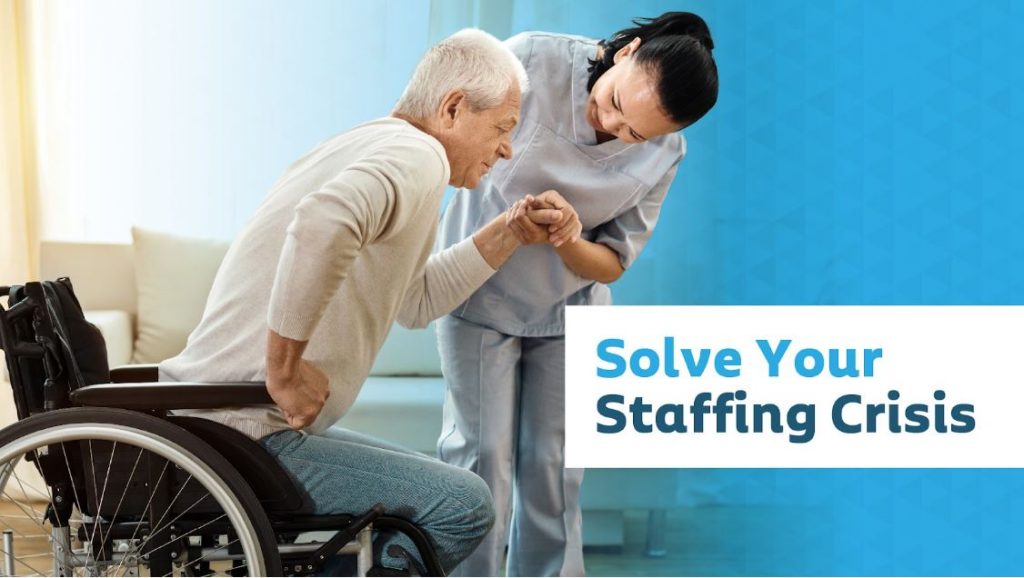Main Menu
Posted by Vayyar
October 8, 2024Recruit, reinforce, and retain: the three Rs of senior care staffing

Recruit, reinforce, and retain should be the mantra of any hiring manager. And those in senior living need it most. The sector still suffers from one of the highest turnover rates of any industry. When it comes to attracting, developing, and keeping a senior living workforce, operators need better technology – smarter sensors and deeper data – to support their vital work. Fortunately, the rapid evolution of remote monitoring technology now supports stable and sustainable solutions to the senior care staffing crisis.
The Front Line Fades: Tackling Senior Care Staffing Attrition
After shedding around 235,000 workers since March 2020, 99% of nursing homes continue to grapple with severe staffing shortages. Meanwhile, over half of assisted living communities are still experiencing painfully high annual turnover among direct caregivers:
- 47.1% for resident assistants / personal care assistants
- 41.8% for certified nursing assistants
- 38.6% for licensed practical nurses
- 34.7% for registered nurses
Senior care staffing turnover not only damages continuity of care. It also impacts resident safety. Overstretched teams may be unable to attend to residents in a timely fashion. In emergency scenarios such as falls, the result could be a long lie, with potentially catastrophic consequences.
Staff morale inevitably suffers after a serious failure of care. To some extent, they’re two sides of the same coin. In fact, operators rank staff retention and fall detection as their two core challenges, at 41% and 37% respectively.
High turnover in senior care staffing even jeopardizes the existence of communities. 55% of nursing homes are having to limit admissions, disrupting the organization’s entire business model, while the newly introduced nursing home staffing mandate is threatening the survival of many SNFs, particularly those in rural areas. Change is urgently required.
Recruit: tech attracts talent
In a seller’s employment market, providers clearly need to compete for hires by offering attractive compensation and conditions. But care is a vocation. Caregivers also want to see commitment from their employers in the form of investment in mission-critical technology.
Caregivers know what they want. They demand tech that helps to:
- prioritize and streamline care delivery
- achieve optimal resident outcomes
- prove that they’ve delivered on their duty of care
- enhance communication with their colleagues
Overworked staff lack the time for detailed conversations with residents. They’re missing out on vital information relating to health and wellbeing. They may be unaware of minor falls that make subsequent, serious falls much more likely. And they may not know about behavioral changes that could signify a serious health issue and increased fall risk.
Operators need next-generation sensors and remote monitoring systems that can gather detailed resident activity and falls data. These systems tell caregivers when a nurse call alert is a real fall and not simply a request for assistance. They measure response time after a fall. And they provide comprehensive fall histories for each resident, allowing staff to collaboratively assess risk and prioritize care delivery accordingly.
Caregiver recruitment programs need to leverage such systems not only to improve care, but also as selling points to prospective residents and caregivers alike.
Reinforce: progress your people
While burnout may be inevitable for some caregivers, many are in it for the long haul. Operators need to keep them loyal and engaged by developing their skills as healthcare professionals.
When you drill down into the data that caregivers demand, 80% want data on bathroom usage, the same number want confirmation of staff visiting rooms, and 75% want accurate fall detection alerts. And these are just the top of the wish list.
Operators can transform resident outcomes with data analytics platforms that reveal not only overall fall risk to deliver AI fall prevention, but also behavioral data that highlights a range of issues:
- High bathroom usage can indicate a condition such as a UTI
- Increased time in bedroom can suggest reduced mobility or depression
- Less time spent out of apartment can point to lower social engagement
Data is a powerful diagnostic tool. And when you put that tool in the hands of frontline caregivers, you’re reinforcing their abilities, elevating their roles, widening their responsibilities, and enhancing their self-respect. They’ll be better, more effective team-members who’ll stay with you longer.
Retain: celebrating success
Senior living operators have clear business objectives: increasing move-ins, minimizing move-outs, and reducing costs. Achieving all three means higher NOI.
With a fall detection and prevention service that results in better tour-to-move-in conversion rates, fewer falls, and higher length of stay, caregiver KPIs can be exactly aligned with the community’s commercial goals.
Supported by state-of-the-art technology and driven by data, caregivers can be recognized for their achievements in enhancing both resident and business outcomes, increasing senior care job satisfaction and boosting retention rates.
Smart synergy for senior living providers
It’s commonplace to regard AI as a threat to people’s livelihoods. Senior care, however, is a special case, where tech is a complement, not a form of competition. Robots are never going to replace the human touch our elders demand and deserve. What technology can do is enhance caregivers’ visibility, decision-making, and efficiency.
Vayyar Care’s fusion of smart sensors and advanced analytics is a workforce multiplier that senior living employees at every level need to fully embrace. For providers, it’s the key to recruiting, reinforcing, and retaining caregiver talent, solving the senior care staffing crisis once and for all.
The Post URL was successfully copied to your clipboard



